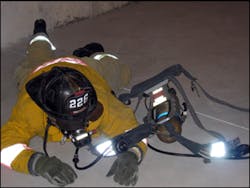SCBA Considerations - Part 3: Restrictive Area Techniques
We pick up this series discussing the aspects of getting through tight or restricted areas while wearing an SCBA Every firefighter needs to be thoroughly familiar and confident with the specific piece of breathing apparatus that they will use. Unexpected circumstances will sometimes take place on the fireground and firefighters need to be given every option possible to save themselves or aid the Rapid Intervention Team in their rescue. Training prior to an event will definitely help increase a firefighter's chances of survival in an emergency.
Firefighters caught in a collapse or cut off from their means of egress may have to fit through a tight spot to get themselves to safety while wearing their SCBA Whenever going through obstacles, it is paramount that firefighters make certain that conditions on the other side are safe. It is also highly recommended that firefighters train on these techniques with their firefighting gloves in place so that they become confident in working with the different components of their SCBA in less than ideal conditions without compromising their safety.
Tight Obstacle: SCBA Shift
A conventional way for firefighters to get through an obstacle is to simply shift their pack to the left side. The SCBA will be shifted to the firefighter's left side to allow protection of the regulator or pressure reducer. It will also allow more freedom of movement for the firefighter because lines from these devices to the facepiece are located on the left side of the S.C.B.A. on most units.
To shift the SCBA:
- The left side shoulder strap is loosened first followed by the waist strap being extended.
- The SCBA is now shifted over to the left as far as possible, allowing the firefighter's profile to be reduced. It may be necessary for a larger framed firefighter to remove their right arm completely from the shoulder strap to accomplish this maneuver. (see photo 1)
- After the obstruction is cleared, the SCBA is shifted back into the center of the back and the straps are tightened once again.
Backwards Swim
Another method for a firefighter fitting through a tight space such as wall studs with a SCBA is to swim through the obstacle backwards. Advantages of this technique are that a firefighter is not required to remove or loosen any part of their SCBA which can slow an escape considerably.
To perform the backwards "swim":
- The firefighter seats themselves with their back against the wall with their SCBA centered between two obstacles. (see photo 2) The firefighter's feet should be positioned out in front of their body as far as possible while their buttocks is raised off the ground. This is the key to this technique working. (see photo 3)
- The firefighter then pulls their shoulders and elbows inward towards the center of their body while pushing backwards through the space.
- Once the neck of the SCBA cylinder is clear of the wall stud, the firefighter should rotate their body and employ a "swim" type maneuver to bring the rest of their body through the obstacle. (see photo 4)
Another simple method for a firefighter to reduce their profile to clear an obstacle is to perform a "forward dive" technique.
To execute the forward dive:
- Centering themselves between the wall studs or obstacle, the firefighter places both arms in front through the obstacle. (see photo 5)
- As the firefighter exhales, they pull their arms inward towards the center of their body allowing them to fall forward through the obstacle.
- Once the SCBA is clear of the obstacle, they can use their arms to pull themselves the rest of the way through. (see photo 6)
Firefighters may have to get beneath an obstacle to facilitate their escape which may also require them to lower their profile. The SCBA can be shifted to the left side by loosening the shoulder straps just as if the firefighter where advancing in an upright position.
Dire Emergency: S.C.B.A Removal
In a very extreme circumstance, a firefighter may have to resort to removing the SCBA from their body to facilitate clearing an obstacle. A firefighter must be very cautious when removing the SCBA as it further complicates the nature of the situation that the firefighter is presented with. The SCBA should not be removed from the firefighter's back unless absolutely necessary.
To remove the SCBA in a constricted area or if heat conditions dictate a firefighter be as low as possible, the following steps can be followed:
- While lying to the side, the firefighter will have to loosen the shoulder straps and remove the waist belt of the SCBA
- The firefighter should next "roll" out of the pack by rolling over to the left. By going to the left will allow the firefighter increased freedom of movement. (see photo 7)
- To further facilitate freedom of movement, the SCBA should be rotated so that the cylinder valve is facing away from the firefighter. All straps will need to be placed in a neat organized manner on top of the SCBA. to facilitate an easy redonning.
- The firefighter should then move with the SCBA. in front of them, but keeping it close to their body to protect it and prevent the facepiece from being pulled off. It is imperative that the firefighter makes certain that no holes or elevation changes exist in the floor as they move forward. When clear of the obstacle, the firefighter can redonn the SCBA by laying out the straps and rolling back into the pack.
The fireground is a very dynamic and dangerous environment. Every firefighter from the most seasoned veteran to the greenest rookie can experience a problem with their SCBA.Emergency procedures should be second nature to all firefighters. As with all aspects of firefighting, practice and training prior to an emergency will only increase a firefighter's chance for survival.
